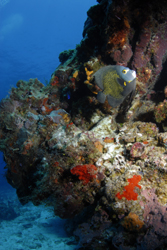Modelling the carbon cycle in oceans with MEDUSA
The Model of Early Diagenesis in the Upper Sediment (A), or MEDUSA, was created by scientists at the Université de Liège in Belgium. MEDUSA is a one-dimensional model that accounts for advection, diffusion and chemical reactions for carbonates, opal and organic matter. Two sediment phases, solid and pore-water, are defined for two different layers: the reactive mixed layer and the historical zone below it. In the context of an EESD Programme RTD project, 6C, MEDUSA was coupled to the Multi-Box Model (MBM) ocean model to study the impact of the ocean mechanisms on carbon dioxide concentrations in the atmosphere (pCO2). The reduction in the ratio of organic carbon to carbonate carbon, known as the rain ratio, during the Last glacial maximum (LGM) and the corresponding drop in pCO2 were, in general, well reproduced. A phase shift was identified in the sediment record simulated by MEDUSA. In particular, the depth of the modelled Calcite transition zone (CTZ) increases during the LGM while actual sediment samples reveal shrinkage. The Université de Liège believes that dissolution of the reactive mixed layer could be the key to resolving this discrepancy. MEDUSA represents a significant improvement over previous, overly simplistic sediment models. In addition to its speed and flexibility, MEDUSA also boasts bi-directional vertical transport, which constitutes a much more realistic picture of reality on the ocean floor. Palaeoceanographers stand to benefit significantly from this development.

